This Lemon Blueberry Cake recipe is the perfect simple dessert for spring or summer! A moist and fluffy lemon cake made with fresh blueberries and a creamy lemon buttercream frosting.

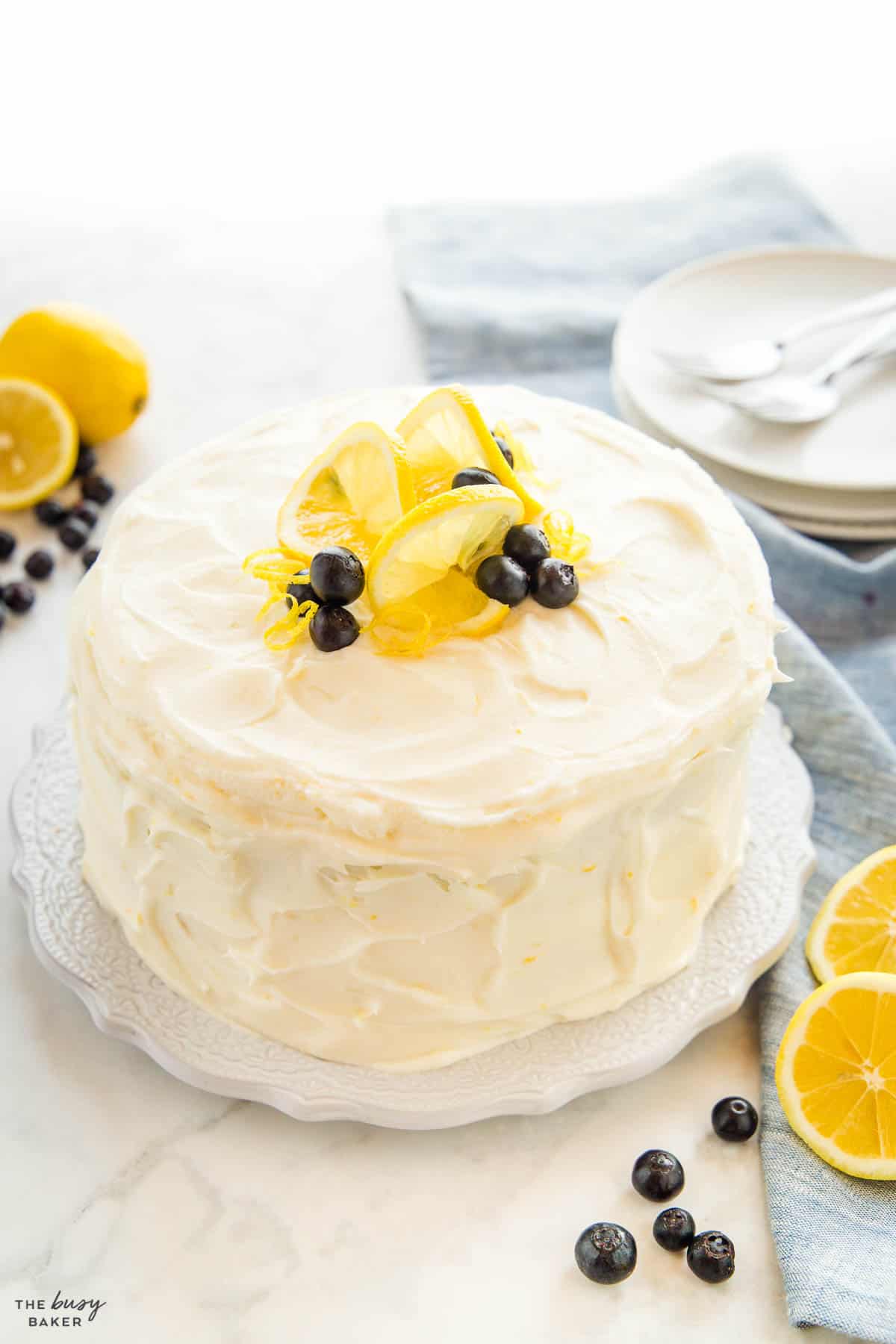

Summer is the season for fresh flavours and there’s nothing more fresh and summery than a lemon cake with blueberries! This Lemon Blueberry Cake recipe is one of our favourite cake recipes to make in the spring and summer because it’s an easy no-fail layer cake recipe made with the easiest and creamiest tangy lemon frosting you’ll ever try.
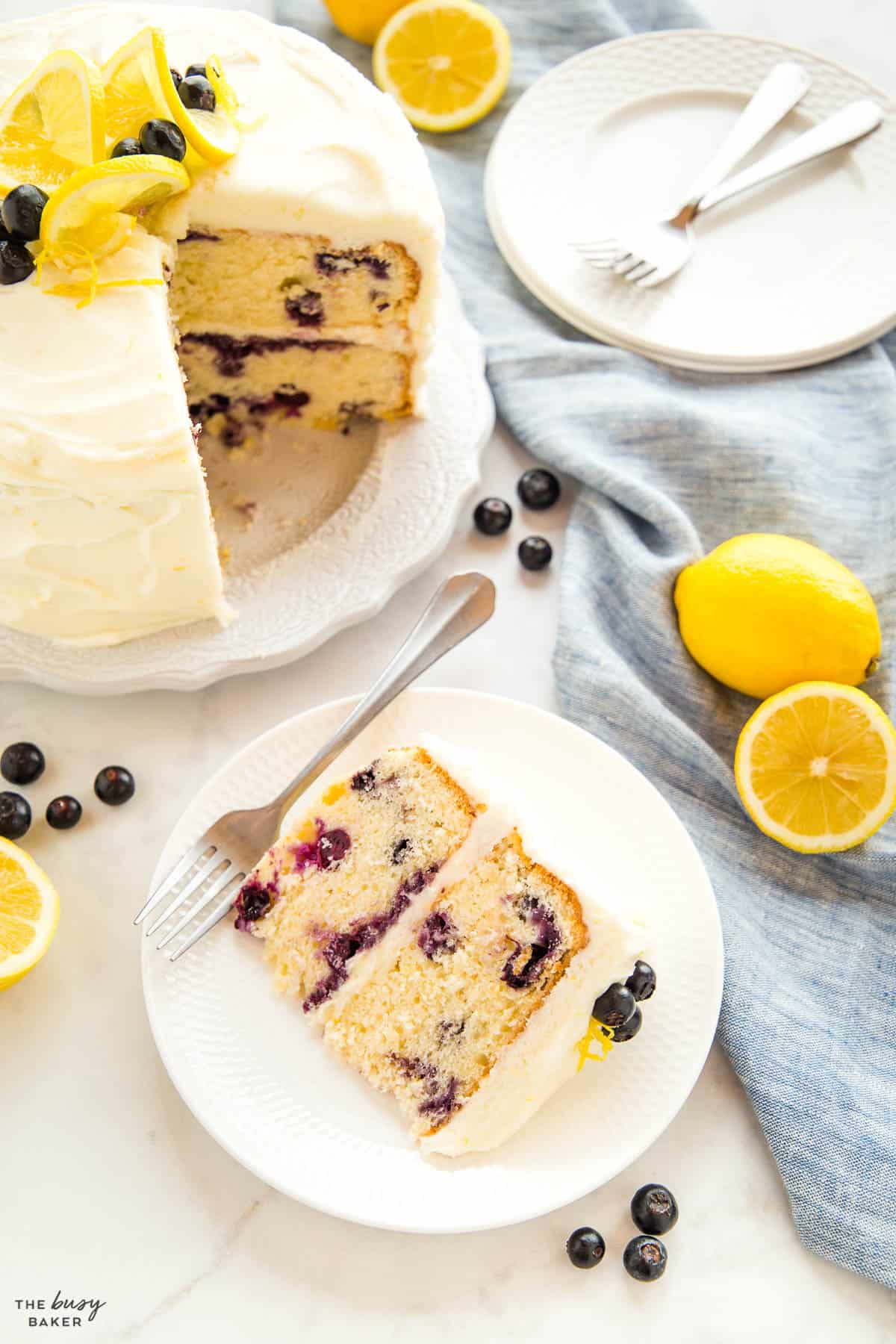
If you’ve ever wondered how to make a lemon cake that actually tastes like lemon, you’ve come to the right place!
We make homemade lemon cake with both the juice of fresh lemons AND the lemon ZEST! The zest of the lemon (the yellow part of the peel) contains a ton of fresh lemon flavour. The best time to add the lemon zest to the cake batter is when you’re creaming the butter and sugar – right at the beginning.
The rough texture of the sugar causes the lemon zest to release its oils into the butter and sugar mixture, and these oils contain all the lemon flavour. This infuses the whole cake batter with a strong lemon flavour, and it’s our favourite way to flavour homemade cakes with lemon without adding any artificial lemon extract.
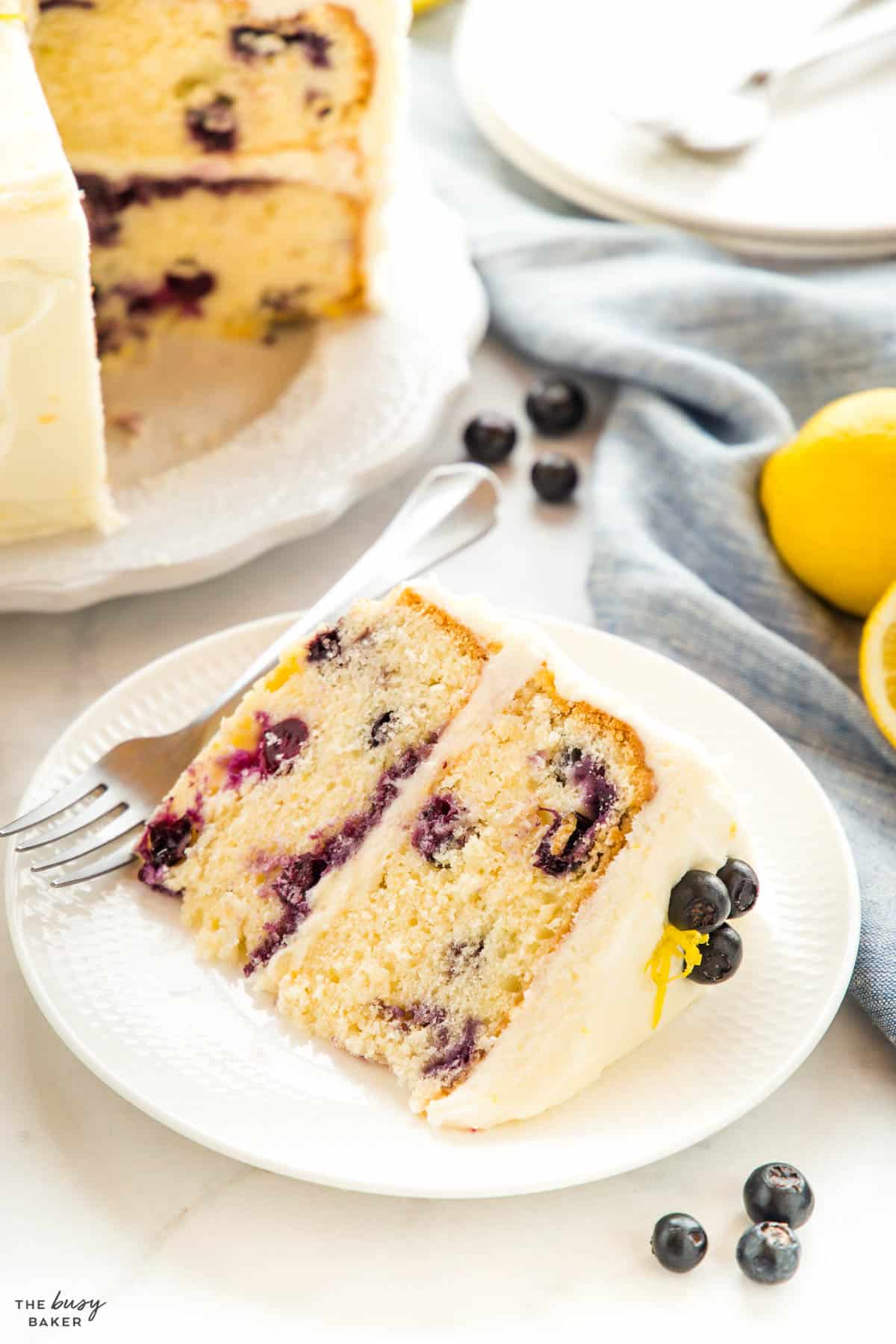
If you’re looking for more delicious desserts for summer we have SO many recipes you’re going to love. Here are some of our favourites:
And there’s even more where that came from. We’ve compiled all our favourite summer desserts in our Summer Desserts e-book, available NOW in The Busy Baker Shop!

EASY AND DELICIOUS SUMMER DESSERT RECIPES YOU’LL LOVE!
Get my no-fail summer dessert recipes e-cookbook!
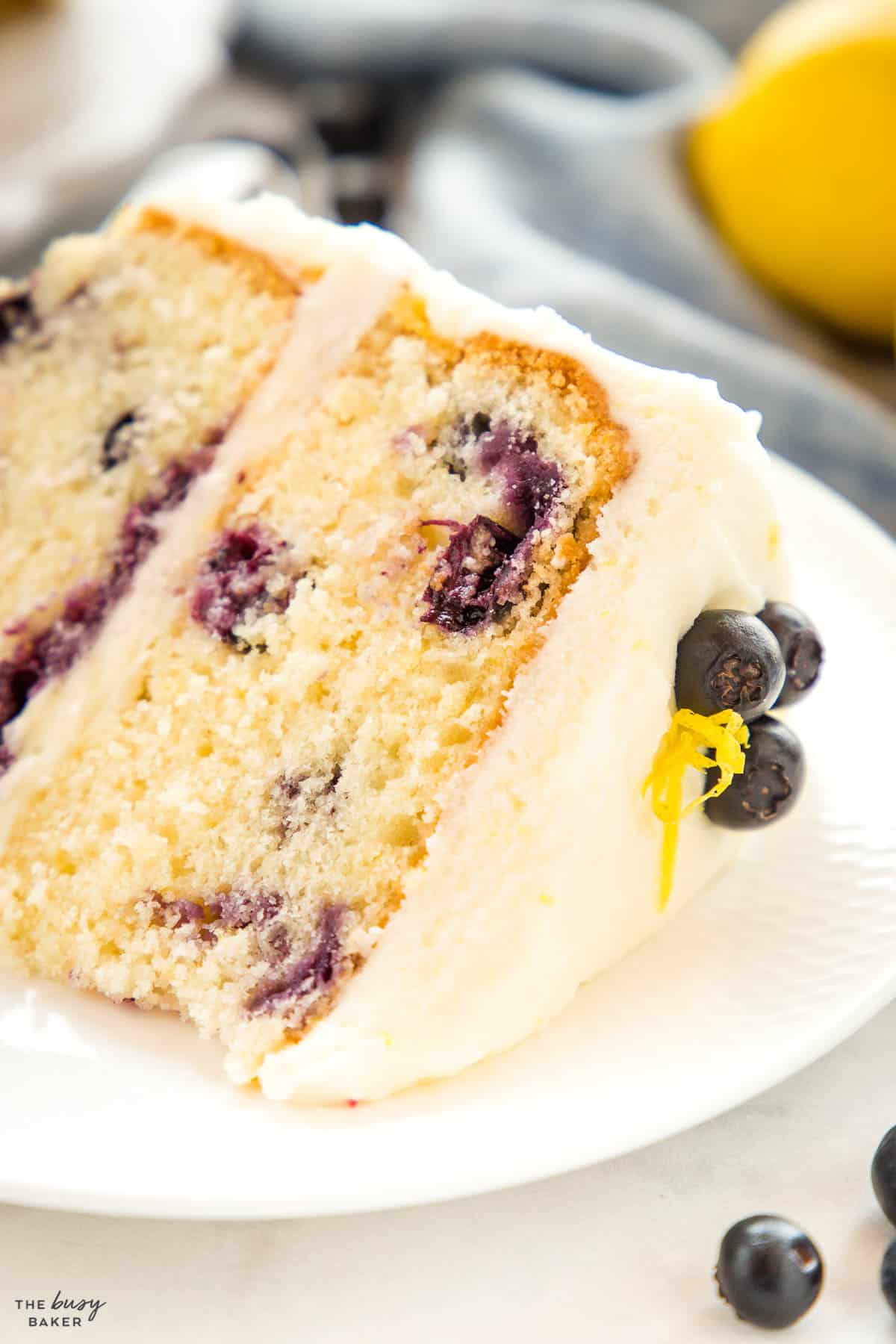
Here are all our BEST Pro Tips for baking cakes from scratch!
- Start with room-temperature ingredients. Make sure your butter, milk and eggs are at room temperature. This will create a smooth cake batter and help the ingredients combine properly.
- Cream the butter and sugar very well. The butter and sugar mixture should be smooth and very creamy, and almost white in colour. This will take several minutes.
- Use unsalted butter. Using unsalted butter is the best way to control the flavour of your cakes. Add the amount of salt provided in the recipe for the perfect balance of flavour.
- Add the eggs one at a time. Mix well after each addition, and use room-temperature eggs. Cold eggs will curdle the batter and cause the fat and water to separate. This can create a tough batter that doesn’t bake properly.
- Don’t over-mix when adding the eggs. Mix only until combined and scrape down the sides of the bowl in between each addition.
- Measure the flour correctly. The best way to measure flour is in grams, but if you’re using cup measurements be sure to fluff the flour in its bag or container before scooping VERY gently (don’t pack the flour into the measuring cup at all), and then level it off with the back of a knife or other flat object.
- Add the milk and flour mixture alternatively. Mix in one third of the flour mixture, then one third of the milk, and so on to create a smooth batter. This process also helps the liquid integrate well into the batter and it cuts down on the amount of mixing required (which creates a more tender cake that’s not tough or dry).
- Avoid over-mixing, especially after adding the flour. Over-mixing can create a dry, tough cake because it reduces the number of air bubbles present in the batter which give the cake its lift as it bakes.
- Don’t mix on high speed. This can create something called tunnelling where long, thin air bubbles appear in the baked cake. This is caused by vigorous mixing that strengthens the gluten strands in the cake batter too much.
- Coat any add-ins in flour first. If you’re adding nuts, berries or other fruit to your cake, reserve one to two tablespoons of flour and coat them in the flour before adding them to the cake batter. This will prevent them from sinking to the bottom of the cake and will prevent berries or other fruit from releasing too much colour or juices into the cake batter.
- Butter and flour the pans properly. Always grease your cake pans generously with butter and dust the inside with flour on all sides. This will prevent the cake from sticking to the pan. We suggest using spring-form pans for baking cakes for even easier removal.
- Smooth out the top of the cake batter in the pans before baking. This will help the cakes not to dome too much when baking. You can also use baking strips (soak them in water before wrapping around the outside of the pan) but if you smooth out the batter well, baking strips often aren’t necessary.
- Bake immediately after mixing. Don’t let an unbaked cake sit out on the counter. Always preheat your oven first and bake the cake immediately after adding the batter to the pans. This will help the cake rise properly in the oven as the leavening agent in the cake batter is activated as soon as the wet and dry ingredients are combined.
- Place the pans in the centre of the oven. Don’t place the pans too close together as this can cause them to brown too much on one side. Add the pans to the centre of the oven so they bake evenly.
- Don’t open the oven as they bake. Avoid opening the oven during baking unless it’s absolutely necessary to rotate the cakes while baking (if your oven is small or has a hot spot). Opening the oven door at the end of the baking time is ok, especially because testing the cake with a toothpick is necessary to prevent over-baking.
- Don’t over bake. Over-baked cakes are dry and crumbly. Be sure to remove them from the oven as soon as a toothpick inserted into the top of the cake comes out clean.
- Don’t under bake. Under-baked cakes are partly baked but gummy on top and in the centre. Test the cake with a toothpick to be sure the cake is baked completely.
- Don’t let them cool completely in the pan. Cool the cakes in the pan only for the first 10 minutes of cooling. Then turn them out onto a cooling rack to cool completely. Cooling the cakes in the pan will trap moisture in and make them soggy.
- Frost only after completely cooled. Don’t try to frost a cake that’s still warm, especially if you’re using a butter-based frosting as the butter will melt and you’ll be left with a mess. Wait for the cakes to cool completely, then frost.
- Level the cakes before frosting. Use a large serrated knife (like a bread knife) to cut any domed top off the cakes before assembling and frosting.
- Chill the cake during assembly. Add whatever filling you’re using between the layers, then chill for 20-30 minutes in the fridge. This will help the filling firm up so the cake keeps its shape as you add the frosting around the outside of the cake.
- Chill the cake before slicing. Place the cake in the fridge once you’ve finished frosting it so the frosting can firm up. This will make the cake easier to slice and create clean, uniform slices.
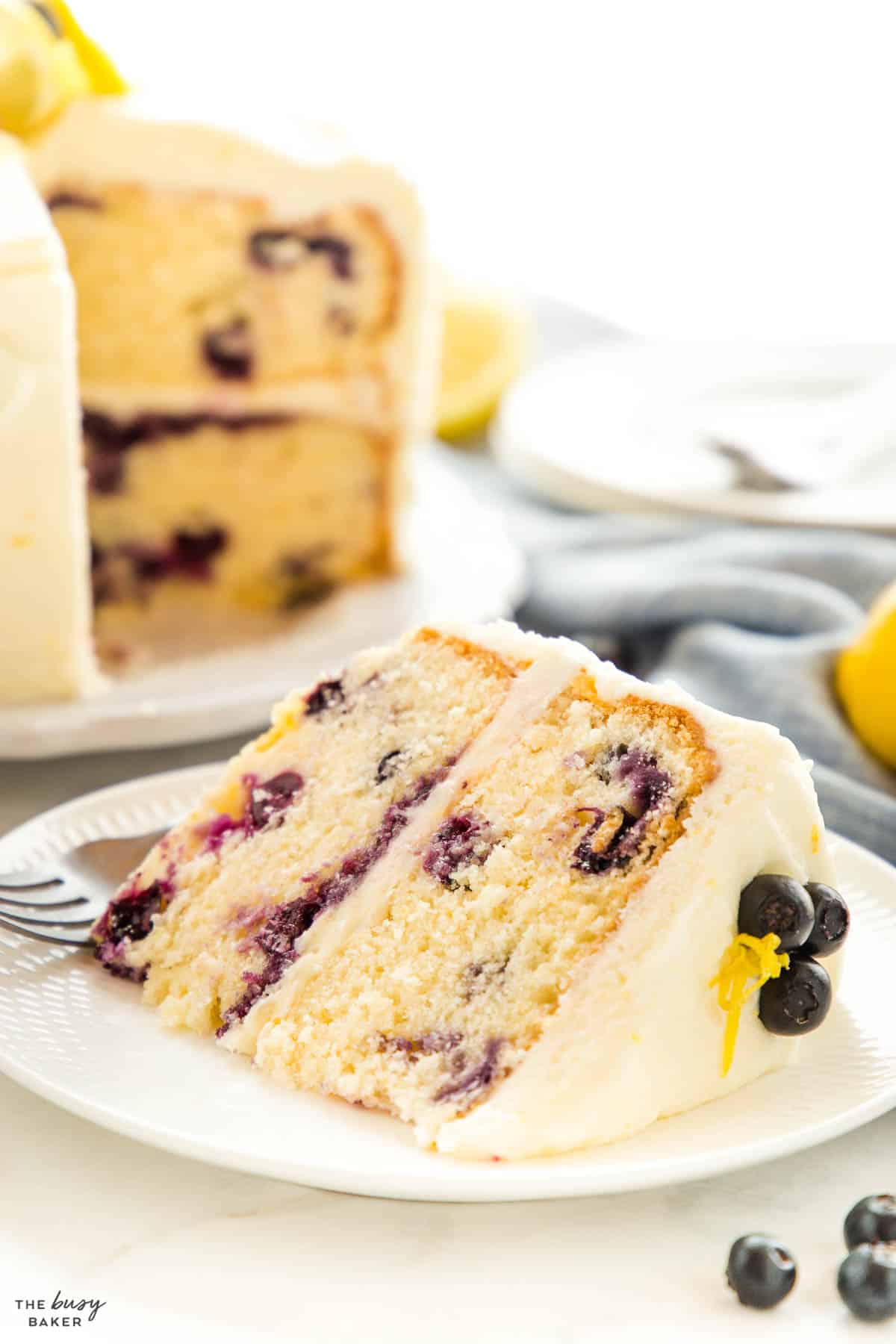
You’ll need a few basic kitchen items to make this Lemon Blueberry Cake (affiliate links):
- a stand mixer or a hand mixer with some mixing bowls
- measuring cups and spoons for dry ingredients
- measuring cups for liquid ingredients
- a silicone spatula
- a microplane zester for zesting the lemons
- 8-inch round cake pans or 9-inch round cake pans
- an offset spatula

To make this lemon blueberry cake recipe you’ll need these ingredients:
- unsalted butter
- granulated sugar
- eggs
- lemons
- milk
- vanilla extract
- all purpose flour
- baking powder
- salt
- fresh blueberries
- full fat cream cheese
- powdered sugar
- heavy cream
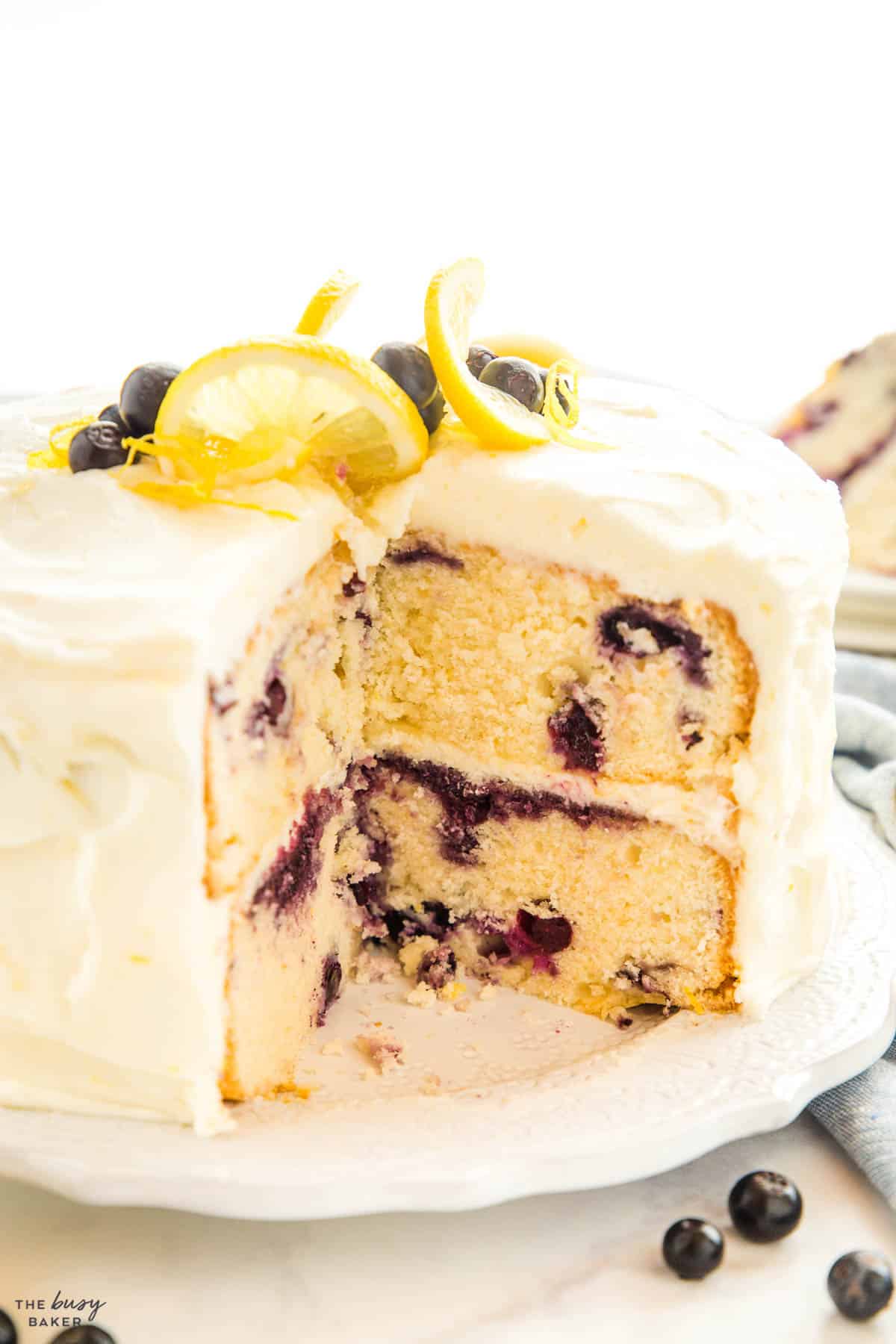
Time needed: 2 hours
Follow these steps for the perfect lemon blueberry layer cake recipe!
- Prepare the cake pans first.
It’s important to bake the cakes right after combining the wet and dry ingredients, so start by preheating your oven and preparing the cake pans first.
- Cream the butter and sugar well.
Mixing the butter and sugar very well gives the cake structure and helps the batter become smooth, making sure the ingredients combine evenly.
- Add the milk and dry ingredients alternatively.
This helps the liquid become absorbed properly into the batter and creates a smooth cake batter.
- Coat the blueberries in flour.
Tossing the berries in flour prevents them from bleeding colour into the batter and prevents them from sinking to the bottom of the cake.
- Cool the cakes before frosting.
Frosting a cake while it’s still warm will cause the frosting to melt. Prepare the frosting when the cakes are cool and frost only after they have cooled completely.
- Level the cakes before frosting.
If your cakes have domed at all while baking, slice off the domed part to level the cakes. This will make the assembly of the layer cake a lot easier.
- Chill the cake before slicing.
Layer cakes slice so much more thinly if you chill them first to let the frosting firm up.

Can I use frozen blueberries for cake?
Yes. Be sure to toss the frozen berries in flour before adding them to the batter to prevent them from colouring the batter purple.
Should you defrost blueberries before baking?
No, it’s better to add frozen blueberries to cake batter, but it’s important to toss them in flour first so they don’t colour the batter.
Why does my lemon cake not taste like lemon?
Adding lemon juice to the batter won’t add much lemon flavour. Be sure to add the zest of the lemon to add so much more lemon flavour.
Why is my lemon cake dry?
Dry cakes are usually over-baked or they contain too much flour and not enough liquid. Be sure to observe the baking time provided in the recipe (and be sure your oven is the correct temperature) and measure the flour properly.
What size cake pan can I use for this recipe?
You can bake this cake recipe in two 8-inch cake pans or two 9-inch cake pans. If you use 9-inch cake pans, you may have to reduce the baking time by 2-4 minutes since they cakes won’t be so thick. Be sure to test the cakes with a toothpick to be sure they’re done.
How to store lemon blueberry cake?
Store the cake in the fridge for 3-5 days or until ready to serve (let sit out at room temperature for 15 minutes before slicing to let the frosting relax).
How to freeze lemon blueberry cake?
You can freeze this cake frosted or unfrosted for up to 3 months, wrapped well in plastic wrap and in an airtight container or freezer bag to protect it from freezer burn. Thaw in the fridge overnight and allow to sit at room temp for 15-20 minutes before serving.
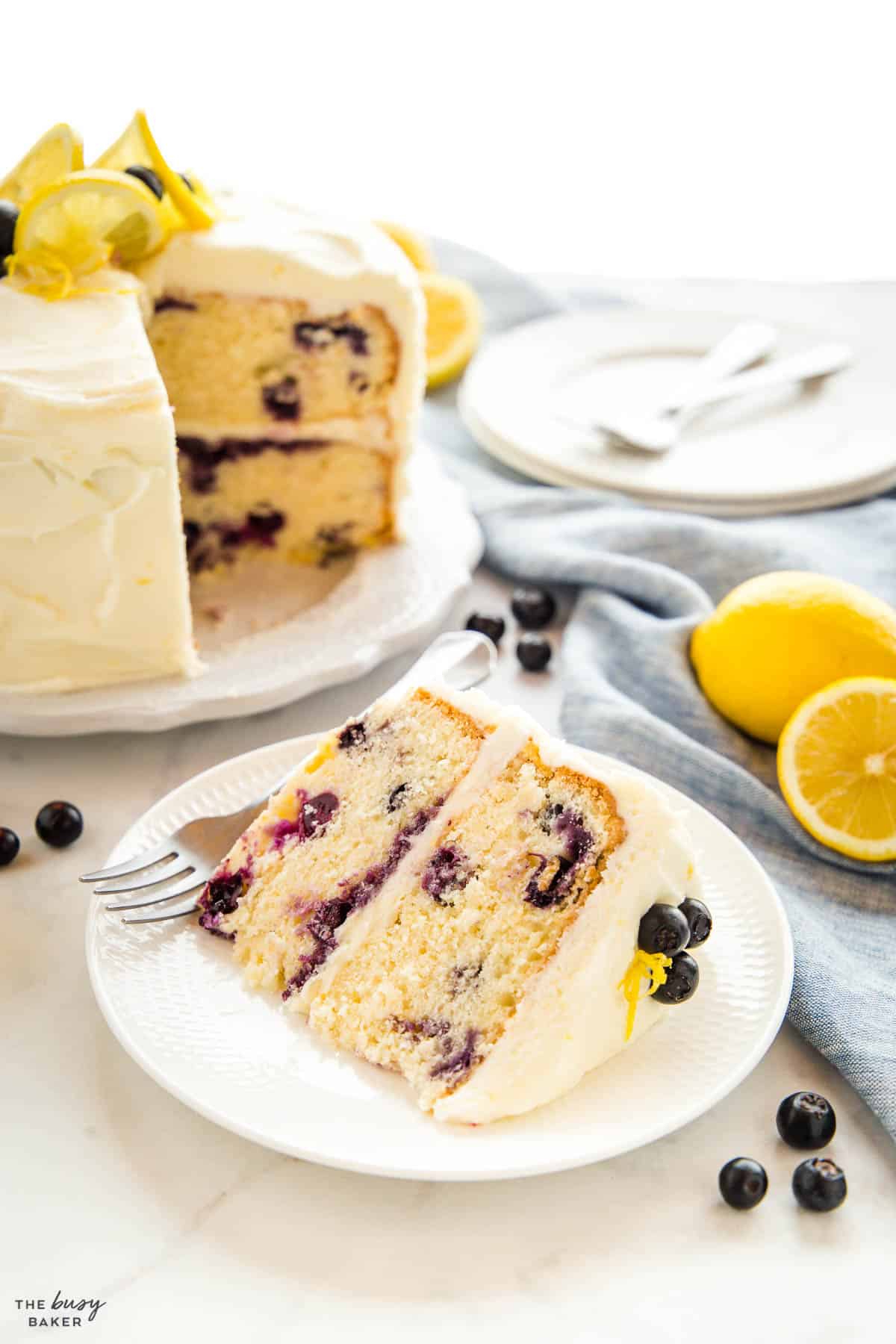
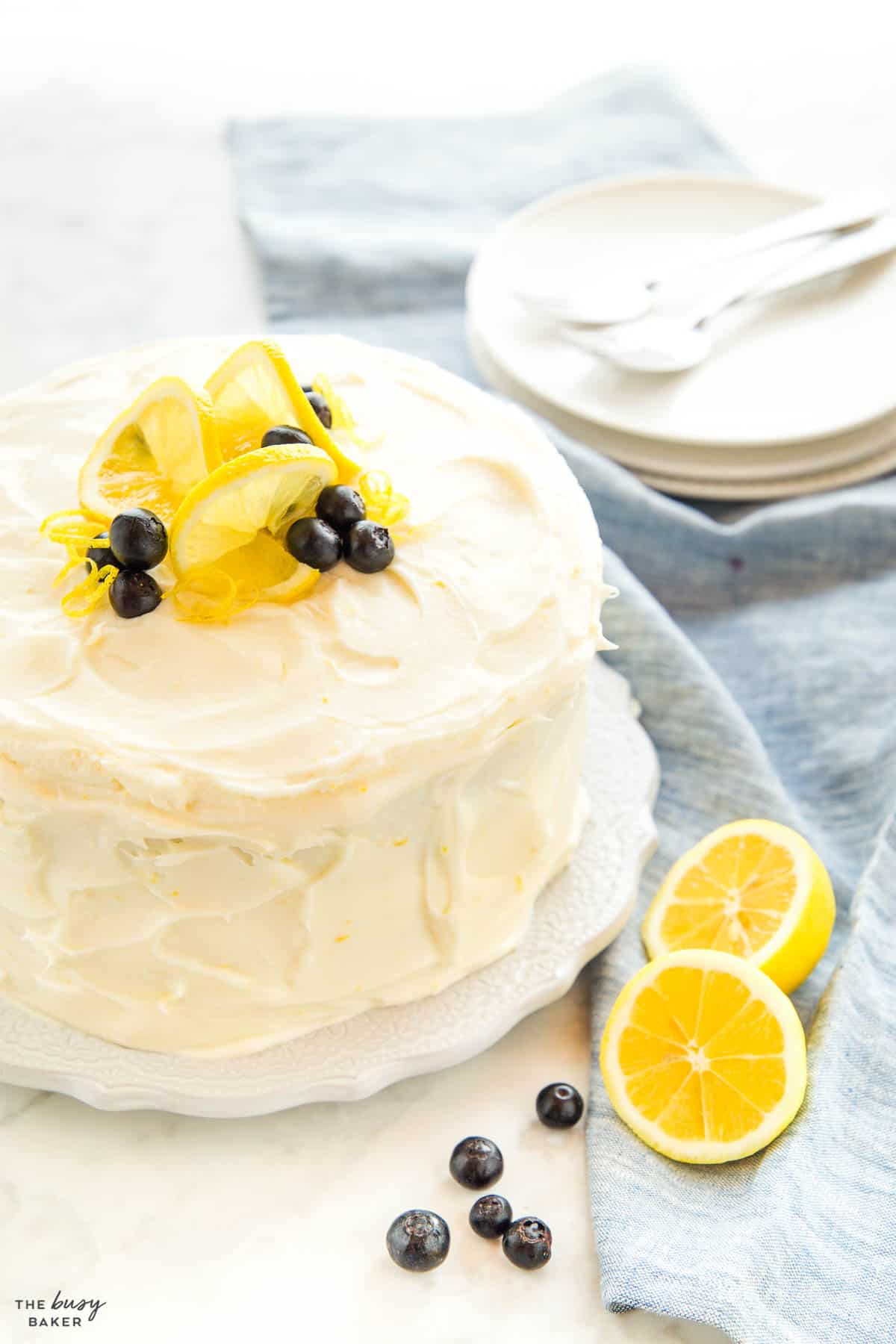
We hope you love this Lemon Blueberry Cake Recipe as much as we do! Let us know in the comments below, what’s your favourite cake recipe for summer? We’d love to know!
Watch the video below to see exactly how we make this recipe. You can find many more deliciously simple recipe videos on our YouTube channel!
If you made this, share a photo!
Are you trying this recipe? Use the comment form below to share your take; now with support for image uploads and comment voting!
Lemon Blueberry Cake

Recipe: Equipment
Recipe: Ingredients
For the cake:
- 1-2 tablespoons each, butter and flour for preparing the cake tins
- 1 cup unsalted butter softened to room temperature
- 2 cups granulated sugar
- 3 eggs at room temperature
- 1 cup milk at room temperature
- juice of 1 lemon
- zest of 2 lemons
- 1 teaspoon vanilla extract
- 3 1/4 cups all purpose flour
- 3 teaspoons baking powder
- 1 teaspoon salt
- 2 cups blueberries fresh or frozen
For the frosting:
- 1 cup unsalted butter softened to room temperature
- 1/2 cup cream cheese plain, full fat, at room temperature
- 4 cups powdered sugar sifted to remove lumps
- a pinch of salt
- 1 tablespoon heavy cream
- zest of 1 lemon
For assembly:
- 3-4 tablespoons blueberry jam
Recipe: Instructions
For the cake:
- Grease and flour two 8-inch round cake pans (with high sides), lining the bottoms with parchment paper rounds for easy release. Preheat your oven at 325 degrees Fahrenheit (165 degrees Celsius).
- In the bowl of your stand mixer (or in a large bowl using a hand mixer) whip the butter on medium high speed until very smooth. Add the sugar and mix on high speed until fluffy and creamy. The sugar will start to dissolve into the butter during this creaming process, so you should be able to feel the grains of sugar getting smaller and less noticeable.
- Add the eggs one at a time, mixing well after each addition. Scrape down the sides of the bowl regularly at this stage to make sure everything is mixed well.
- Mix in the zest of 2 lemons and vanilla extract on low speed.
- Measure the milk into a liquid measuring cup and add the juice of one lemon to it. Mix and set aside.
- Measure and sift the flour, baking powder and salt into a separate bowl and combine with a wire whisk.
- Add the dry ingredients and the buttermilk alternatively while the mixer is running on low speed. Add 1/3 of the dry ingredients, half the milk, another 1/3 of the dry ingredients, the other half of the milk, and the remaining dry ingredients, leaving about 2-3 tablespoons of the flour aside to toss with the berries.
- Add the blueberries to the remaining flour and toss well. Fold them into the cake mixture gently with a spatula.
- Pour the batter into the prepared cake pans, dividing the batter evenly between the two pans. Bake at 325 degrees Fahrenheit (165 degrees Celsius) for about 40-45 minutes, or until a toothpick inserted into the middle of one of the cakes comes out clean.
- Cool the cakes in the pans for about 10-15 minutes and then turn the cakes out of their pans and onto a cooling rack, allowing them to cool completely.
- Once the cakes are cool, store them wrapped in plastic wrap in the fridge until ready to frost.
For the frosting:
- Beat the butter and cream cheese together on high speed until light and fluffy and smooth.
- Sift the powdered sugar and slowly add it to the butter and cream cheese one cup at a time, mixing after each addition. Add the salt and mix until incorporated.
- Add the lemon zest and then the heavy cream slowly, one teaspoon at a time, until incorporated and the mixture reaches spreadable consistency.
Assembling the cake:
- Trim the cakes (if necessary) to level them, using a serrated knife. Place one cake, right side up, on a plate or cake board.
- Spread the blueberry jam on top of the cake in an even layer, leaving a small 1/2-inch border around the edge of the cake.
- Add a large dollop of frosting on top and spread it out gently to reach the edges of the cake. Place the other cake on top of the frosting, upside down so the flat side faces up. It's a good idea to refrigerate at this point – for about 20-30 minutes. This will help the cakes stay together while you frost the top and sides.
- Add the remainder of the frosting to the top of this cake and spread it over the top and down the sides of the cake, making sure to smooth it out to fill in any holes or cracks in the cake and create a wavy pattern.
- Decorate with lemon slices and blueberries.
- Once you've finished frosting your cake, chill it for another 30 minutes to one hour (or even overnight) before serving to set the frosting. After you pull it out of the fridge it will be quite hard, so it's a good idea to let it sit at room temperature again for about 15 minutes before slicing and serving.
Recipe: Notes
How to store lemon blueberry cake
Store the cake in the fridge for 3-5 days or until ready to serve (let sit out at room temperature for 15 minutes before slicing to let the frosting relax).How to freeze lemon blueberry cake
You can freeze this cake frosted or unfrosted for up to 3 months, wrapped well in plastic wrap and in an airtight container or freezer bag to protect it from freezer burn. Thaw in the fridge overnight and allow to sit at room temp for 15-20 minutes before serving.Recipe: Nutrition
Notice: Nutrition is auto-calculated, using Spoonacular, for your convenience. Where relevant, we recommend using your own nutrition calculations.

EASY AND DELICIOUS SUMMER DESSERT RECIPES YOU’LL LOVE!
Get my no-fail summer dessert recipes e-cookbook!
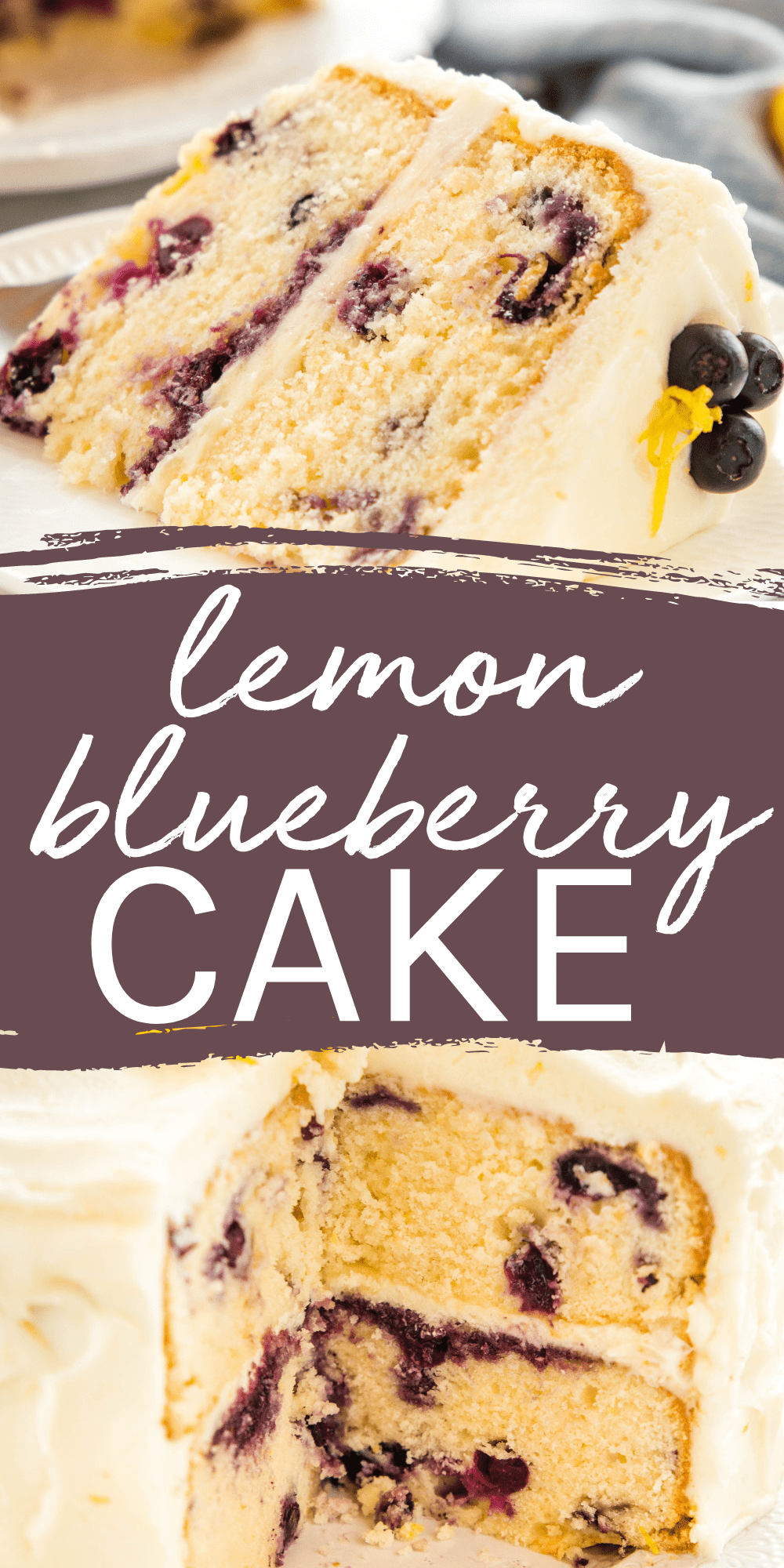

Do you cover the cake when it’s chilling in the fridge, before the final frosting? Thanks. It looks luscious!
No, we don’t. Hope you like it!